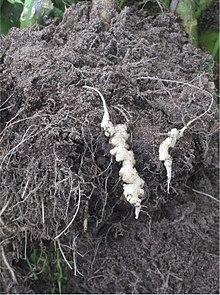
Back Кіла (захворванне раслін) Byelorussian Kohlhernie German Brasika hernio Esperanto Hernia de la col Spanish Ristõieliste nuuter Estonian Hernie du chou French Cnapfhréamh Irish კილა Georgian 뿌리혹병 Korean Kiła kapusty Polish
This article includes a list of general references, but it lacks sufficient corresponding inline citations. (October 2011) |

Clubroot is a common disease of cabbages, broccoli, cauliflower, Brussels sprouts, radishes, turnips, stocks, wallflowers and other plants of the family Brassicaceae (Cruciferae).[1] It is caused by Plasmodiophora brassicae,[2] which was once considered a slime mold but is now put in the group Phytomyxea.[3] It is the first phytomyxean for which the genome has been sequenced.[4] It has as many as thirteen races. Gall formation or distortion takes place on latent roots and gives the shape of a club or spindle. In the cabbage such attacks on the roots cause undeveloped heads or a failure to head at all, followed often by decline in vigor or by death. It is an important disease, affecting an estimated 10% of the total cultured area worldwide.[5]
Historical reports of clubroot date back to the 13th century in Europe. In the late 19th century, a severe epidemic of clubroot destroyed large proportions of the cabbage crop in St. Petersburg. The Russian scientist Mikhail Woronin eventually identified the cause of clubroot as a "plasmodiophorous organism" in 1875, and gave it the name Plasmodiophora brassicae.
In 18th, 19th and early 20th century Britain clubroot was sometimes called finger and toe, fingers and toes, anbury, or ambury, these last two also meaning a soft tumor on a horse.
The potential of cultural practices to reduce crop losses due to clubroot is limited, and chemical treatments to control the disease are either banned due to environmental regulations or are not cost effective. Breeding of resistant cultivars therefore is a promising alternative.[6][7][8]
- ^ Culture of Vegetables and Flowers. 1921. Archived from the original on 2006-03-16. Retrieved 2006-04-04.
- ^ Javed, Muhammad Asim; Schwelm, Arne; Zamani-Noor, Nazanin; Salih, Rasha; Vañó, Marina Silvestre; Wu, Jiaxu; González García, Melaine; Heick, Thies Marten; Luo, Chaoyu; Prakash, Priyavashini; Pérez-López, Edel (2022). "The clubroot pathogen Plasmodiophora brassicae: A profile update". Molecular Plant Pathology. 24 (2): 89–106. doi:10.1111/mpp.13283. PMC 9831288. PMID 36448235.
- ^ Schwelm, Arne; Badstöber, Julia; Bulman, Simon; Desoignies, Nicolas; Etemadi, Mohammad; Falloon, Richard E.; Gachon, Claire M. M.; Legreve, Anne; Lukeš, Julius; Merz, Ueli; Nenarokova, Anna; Strittmatter, Martina; Sullivan, Brooke K.; Neuhauser, Sigrid (2018). "Not in your usual Top 10: Protists that infect plants and algae". Molecular Plant Pathology. 19 (4): 1029–1044. doi:10.1111/mpp.12580. PMC 5772912. PMID 29024322.
- ^ Schwelm A, Fogelqvist J; Knaust A; et al. (2015). "The Plasmodiophora brassicae genome reveals insights in its life cycle and ancestry of chitin synthases". Scientific Reports. 5: 11153. Bibcode:2015NatSR...511153S. doi:10.1038/srep11153. PMC 4471660. PMID 26084520.
- ^ Christianson, J. (2008). Club Root of Crucifers. University of Nebraska-Lincoln. Retrieved from "Club Root of Crucifers Key words: Plant Disease, Plasmodiophora brassicae, cabbage, Chinese cabbage, Brussels sprouts, turnips, wormseed mustard black mustard, tumble mustard, kohlrabi, collards, kale, broccoli, cauliflower, rutabaga, sea kale, radish, rape candytuft". Archived from the original on 2010-07-23. Retrieved 2012-03-22. Mar 2012
- ^ Hybrid Vegetable Development, by P. K. Singh (Ed.), S. K. Dasgupta (Ed.), S. K. Tripathi (Ed.), Haworth Press. ISBN 1-56022-118-6
- ^ NC State University Department of Plant Pathology [1] Archived 2005-12-17 at the Wayback Machine (accessed 27 October 2005)
- ^ Clubroot in the cole crops: the interaction between Plasmodiophora brassicae and Brassica oleracea